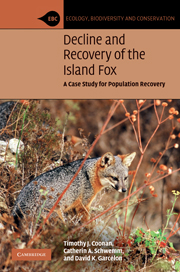Book contents
- Frontmatter
- Contents
- Foreword
- Acknowledgments
- 1 Introduction
- 2 Evolution and genetics
- 3 Social structure, reproduction, mortality and survivorship, and population dynamics
- 4 Food habits, habitat use, activity patterns, and dispersal
- 5 Golden eagles and the decline on the northern islands
- 6 Ecosystem recovery
- 7 Disease and decline on Santa Catalina Island
- 8 Recovery actions
- 9 Recovery actions
- 10 Reproductive biology, by Cheryl Asa
- 11 Diseases of island foxes, by Linda Munson
- 12 Zoos, education, and public participation
- 13 Managing recovery
- 14 The ecological role of island foxes
- 15 Conclusion
- References
- Index
8 - Recovery actions
Captive breeding of island foxes
Published online by Cambridge University Press: 05 October 2010
- Frontmatter
- Contents
- Foreword
- Acknowledgments
- 1 Introduction
- 2 Evolution and genetics
- 3 Social structure, reproduction, mortality and survivorship, and population dynamics
- 4 Food habits, habitat use, activity patterns, and dispersal
- 5 Golden eagles and the decline on the northern islands
- 6 Ecosystem recovery
- 7 Disease and decline on Santa Catalina Island
- 8 Recovery actions
- 9 Recovery actions
- 10 Reproductive biology, by Cheryl Asa
- 11 Diseases of island foxes, by Linda Munson
- 12 Zoos, education, and public participation
- 13 Managing recovery
- 14 The ecological role of island foxes
- 15 Conclusion
- References
- Index
Summary
Captive breeding and reintroduction, especially on Santa Rosa and San Miguel Islands, was the one recovery action that could not fail if island foxes were to be recovered. If the handful of remaining San Miguel and Santa Rosa animals did not produce young before they died, those subspecies would be lost. Island foxes had never been bred in captivity, so it was unknown how adaptable they would be to captive conditions. As it turned out there were significant challenges to captive breeding, primarily less than ideal reproductive success, injuries to females from aggressive males, and considerable perinatal mortality. Despite such difficulties, captivity protected the northern foxes from golden eagles until eagles could be removed, and productivity was high enough that foxes could be released beginning less than five years after the program began. Once foxes were released the wild populations grew quickly (Chapter 9), and captive breeding ended on Santa Catalina in 2005, on San Miguel and Santa Cruz in 2007, and on Santa Rosa in 2008.
Captive breeding efforts on the northern islands
Developing an island fox captive breeding program was a unique challenge for NPS, which had not previously managed such a program and had minimal fiscal resources with which to begin one. The recommendation from an outside group of experts (the Island Fox Conservation Working Group [IFCWG], Chapter 13) to initiate island fox captive breeding provided the agency with a justification for taking the drastic step of removing all of the remaining individuals from the wild, a very difficult decision to make in rare species conservation (Hendron 1998).
- Type
- Chapter
- Information
- Decline and Recovery of the Island FoxA Case Study for Population Recovery, pp. 81 - 99Publisher: Cambridge University PressPrint publication year: 2010



